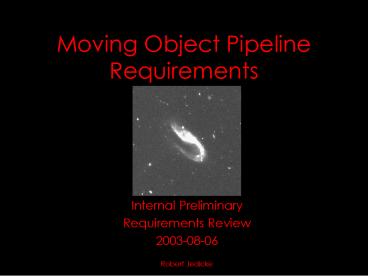Moving Object Pipeline Requirements PowerPoint PPT Presentation
1 / 34
Title: Moving Object Pipeline Requirements
1
Moving Object PipelineRequirements
- Internal Preliminary
- Requirements Review
- 2003-08-06
- Robert Jedicke
2
Outline
- Background
- Requirements
- Selected Derived Requirements
- Crazy Random Thoughts
3
MBO Sky-Plane Distribution
Main Belt Objects
4
PHO Sky-Plane Distribution - Sunset
Potentially Hazardous Objects End of Twilight Ton
ight
Sunset
Midnight
Sunrise
5
PHO Sky-Plane Distribution - Midnight
Potentially Hazardous Objects Midnight Tonight
6
PHO Sky-Plane Distribution - Sunrise
Potentially Hazardous Objects Start of Twilight T
omorrow Morning
7
MO Sky-Plane Density
- 107 asteroids with V
- 200/deg2 along ecliptic incl. sweet spots
- 300/deg2 _at_ oppn.
- 100/deg2 w/ lopp
300,000 MO/night!
8
Unit Exposure Time (UET)
- All images acquired in a filter and sky dependent
Unit Exposure Time - Longer exposures built up by combining multiple
Unit Exposure images - E.g. 30s in solar system filter
9
Transient Time Interval (TTI)
- Exposures built up of ? 2 Unit Exposures
separated by a Transient Time Interval - Allows separation of stationary and
non-stationary transients - 15-30 minutes? Position dependent.
- Need to balance detection of Moving Objects
against (e.g.) GRB detection delays against
weather
10
Transient Ubiquity
- ? (almost?) all observing modes contribute to
detection of transient stationary and moving
objects.
11
Background Noise
- 200 false 5-sigma transients / deg2
- About the same density as real moving objects on
the ecliptic - 200,000 3-sigma detections / deg2
12
T0 image 200 real 200 false
T 0 min
1 deg2
13
T0 image 200 real 200 false
T 15 min
1 deg2
14
T0 image 200 real 200 false
Superimposed
1 deg2
15
Moving Object Pipeline Schematic
16
Moving Object Pipeline Requirements
- Identify moving objects in the non-stationary
transient catalog and, when possible, link
observations of the same objects together and
determine their orbits - Identify objects which pose a collision hazard
with Earth and then determine the risk of impact.
17
Moving Object Pipeline Requirements
- Make all moving object catalogs, orbits and
impact risk assessments available to the
international community as soon as possible. - Must be capable of self-monitoring performance
and provide useful feedback to the user.
18
Derived Requirement 1
(Requirement 1)
- Inputs
- Observation Time (e.g. UT, JD)
- Centroid position (RA, DEC) coordinate system
(e.g. J2000, B1950) - Magnitude, S/N
- Filter (e.g. V, R)
- Ellipticity, orientation, etc
- Error estimates for all values
19
Derived Requirement 2
(Requirement 1)
- Designating
- Unique assignment of identifier to each probable
Moving Object - Unique assignment of identifier to orbits of
linked observations
20
Derived Requirement 3
(Requirement 1)
- Linking Long-Arc Orbits to Observations
- Must be able to link new observations of
previously observed objects with earlier good
orbit determined for that object if it exists
21
Derived Requirement 4
(Requirement 1)
- Linking Short-Arc Orbits to Observations
- Must be able to link new observations of
previously observed objects with earlier weakly
determined orbit for that object if it exists
22
Derived Requirement 5
(Requirement 1)
- Linking intra-lunation observations
- Observations of the same object within a lunation
which do not link to long or short arc should be
linked to each other.
23
Derived Requirement 6
(Requirement 1)
- Linking Short-Arc Orbits to Short-Arc Orbits
- Short-arc orbits identified in one lunation may
be linked to short-arc orbits found in other
lunations
24
Derived Requirement 7
(Requirement 1)
- Linking Long-Arc Orbits to the Transient Object
Database - Once an orbit is well-established you can mine
the 3-sigma non-stationary transient detection
database for pre-coveries of the object to
further improve the orbit.
25
Derived Requirement 8
(Requirement 2)
- Potentially Hazardous Object Risk Analysis and
Warnings - About 2 (50/2400) of NEOs currently have
non-zero collision probability. - PanSTARRS aims to reach 90 completion of all
NEOs to about 200-300m diameter (15,000) - PanSTARRS will detect many smaller objects as
well so we assume a total of 30K NEOs - ? over the lifetime of the project there may be
about 600 Potential Impactors at any time.
26
Derived Requirement 9
(Requirement 3)
- Distribution of Orbits, Observations and Risk
Analysis to the Worldwide Community - In nearly real time
27
Derived Requirement 10
(Requirement 4)
- Performance Monitoring
- To quantify, monitor and test performance of the
moving object pipeline - E.g. perhaps maintain a database of 107 fake but
realistic objects (NEO, MBO, KBO) which are
injected into the pipeline at some TBD point.
28
Derived Requirement 11a
(Requirement 3)
- Output
- Observation Database(s)
- 3-sigma non-stationary unlinked detections
- 5-sigma unlinked detections
- Linked detections
- High-probability observations of objects with
well-determined orbits - Lower-probability observations of objects with
only short-arc orbits
29
Derived Requirement 11b
(Requirement 3)
- Output
- Orbit Database(s)
- High quality long-arc orbits
- Low quality short-arc orbits
30
Crazy Random Thoughts
- Chesley has estimated that implementing a MO
Pipeline would require 5-10 person-years based on
experience at AstDys and JPL. - Minor Planet Center currently employs 3 people to
monitor/maintain
31
Crazy Random Thoughts
- Much of the Moving Object Pipeline is already
performed at the Minor Planet Center (MPC) - MPC currently handles 20,000 objects/day
- Spahr (MPC) says they could handle 2-3? the data
rate with some difficulty - THEY ARE WITHIN A FACTOR OF 10!
32
Crazy Random Thoughts
- JPL (Yeomans), Lowell (Bowell) and AstDys
(Milani) already handle many parts of the Moving
Object Pipeline - None of them (including MPC) are fully automated.
They still require human intervention in their
procedures. This is not acceptable for
PanSTARRSs data rate.
33
Crazy Random Thoughts
- Do we want to become the MPC?
- What parts do we need to implement?
- Team Asteroid meets tomorrow to (politely)
discuss many of these issues.
34
The End
THE END

